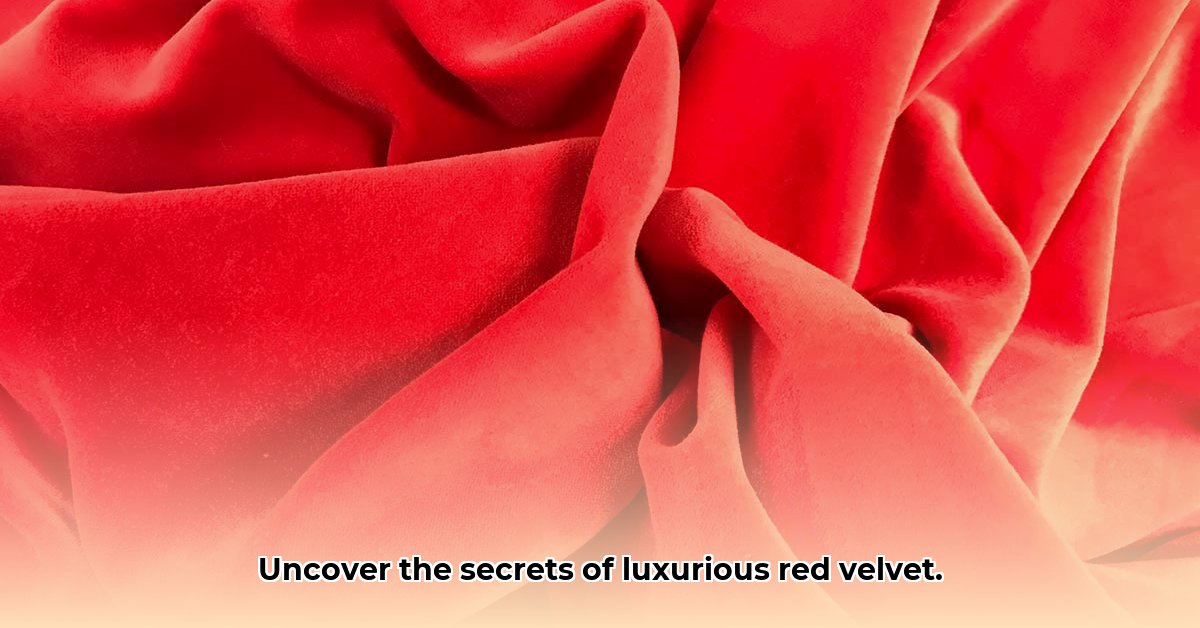Red velvet: it’s luxurious, it’s dramatic, and it can be a bit confusing to buy. This guide cuts through the fluff and helps you find the *perfect* red velvet for your needs, whether you’re making a dress, reupholstering a chair, or just want to add a touch of glam to your space. We’ll cover everything from the differences between silk, cotton, and polyester velvets to where to buy it, sustainable options, and how to care for it. So whether you’re a pro or a beginner, get ready to become a red velvet expert! For plush velvet cushions, check out these [red throw pillows](https://www.wavesold.com/red-throw-pillows/).
Red Velvet Cloth: Your Ultimate Buying Guide
So, you’re drawn to the alluring depth of red velvet? Fantastic! But before you dive in, let’s unravel the secrets behind this luxurious fabric. It’s more than just a color; it’s a world of textures, fibers, and possibilities. Choosing the right red velvet can transform a simple project into something truly special. The decision hinges on understanding the nuances of fiber content, texture variations, intended applications, and ethical sourcing, ensuring that your final selection perfectly aligns with your creative vision.
Diving Deep into the Crimson: Understanding Red Velvet Types and Fabric Composition
The first thing to know? Not all red velvets are created equal. The differences go beyond just shades of red; they involve the very fabric of the material itself. Think of it like choosing a wine – some are light and fruity, others bold and complex. The same holds for red velvet. Understanding the fiber content and construction of red velvet is crucial for making an informed purchasing decision.
The most significant difference lies in the fiber that makes up the cloth. Silk velvet is the undisputed champion of luxury. Its incredibly smooth drape and incomparable softness make it a favorite for high-end fashion and interior design. However, this opulence comes with a hefty price tag and potentially higher maintenance. If luxury is your goal, but your budget is more modest, cotton velvet is a fantastic alternative. It’s significantly softer than polyester velvet and offers a luxurious feel without breaking the bank, though it may not be as durable as synthetic options. Then there’s polyester velvet. While it lacks the inherent softness of silk or cotton, it’s incredibly durable, wrinkle-resistant, and easy to care for – ideal for high-traffic areas or projects where longevity is a priority, and is often the most budget-friendly option. The choice really depends on what you’re making and how much you’re willing to spend, with silk positioned as the most luxurious yet most expensive option, polyester as the most practical, and cotton balancing cost and comfort.
Texture Talk: Exploring Velvet Surface Techniques and Visual Appeal
Red velvet isn’t just one texture. Oh no, it’s a whole spectrum of tactile experiences. Imagine the subtle shimmer of a flawlessly smooth velvet, perfect for a glamorous evening gown. Then picture the dramatic, almost theatrical folds of crushed velvet, lending a more relaxed, bohemian vibe to a sofa or armchair. Embossed velvet, with its raised patterns, offers a unique visual texture, providing a sense of structured elegance. Quilted velvet, on the other hand, adds another layer of dimension, working beautifully in upholstery or for creating richly textured garments like headboards or throw blankets.
Beyond these, consider panne velvet, known for its sleek, directional pile created by pressing the fabric in one direction. Pile direction can dramatically affect how light reflects off the fabric and influences the perceived color depth. Burnout velvet, also known as devoré, features a pattern created by chemically dissolving portions of the pile, resulting in a design with sheer and opaque areas. Stretch velvet incorporates spandex or Lycra, making it ideal for form-fitting garments and costumes. Choosing the right texture is about matching the feel to your project’s purpose and desired aesthetic, which ensures your creative vision is beautifully realized.
Red’s Richness: Navigating Shades of Red Velvet
The world of red velvet extends far beyond a single shade. Crimson offers a deep, classic red with a slight blue undertone, evoking a sense of timeless elegance. Scarlet is a brighter, more vibrant red with orange undertones, perfect for making a bold statement. Burgundy leans towards a deeper, wine-like hue that conveys sophistication and warmth. Cherry red is a playful, bright red reminiscent of ripe cherries, ideal for adding a pop of color. Ruby red, named after the precious gemstone, is a rich, luxurious red with a hint of pink, exuding opulence. Mahogany is a darker, reddish-brown shade, offering a more subtle, earthy take on red velvet. When selecting your red, consider the existing color palette of your project and the mood you want to create. A deep crimson velvet might be ideal for a formal setting, while a vibrant scarlet could add energy to a more casual space.
Where Will Your Red Velvet Shine? Finding the Perfect Application for Your Project
The versatility of red velvet is truly remarkable. In the world of fashion, it’s a timeless classic, lending itself to elegant gowns, sophisticated jackets, and eye-catching accessories. Imagine a floor-length crimson velvet gown with a dramatic train, a tailored blazer in ruby red, or a chic clutch in crushed burgundy velvet. In interior design, it transforms ordinary spaces into opulent havens. Imagine the richness it would add to curtains, cushions, or even a statement headboard. Picture floor-to-ceiling velvet curtains in a deep red, accent cushions in quilted velvet, or a luxurious headboard upholstered in smooth scarlet velvet.
It’s even a staple in theater and film, where its dramatic presence enhances costumes and set designs alike. Think of the regal robes of a king in a historical drama or the sensual dress of a femme fatale in a film noir. Beyond these, red velvet finds applications in crafting, event decor, and even specialty items like jewelry boxes and holiday ornaments. Understanding how you plan to use your red velvet will guide your decisions about weight, texture, and durability. A lightweight velvet might be perfect for a flowing dress, while a heavier-weight variety would be better suited for upholstery, ensuring the fabric’s suitability for the intended use.
Your Practical Guide to Choosing Red Velvet: A Step-by-Step Approach
Embarking on a red velvet project? Follow these helpful steps to ensure you’re selecting the perfect fabric for the job.
- Envision Your Masterpiece: What’s your project? A stylish dress? Luxurious curtains? Sturdy upholstery for a chair? This initial vision will dictate the amount of fabric you need, the ideal weight, and the perfect texture.
- Fiber Focus: Weighing the pros and cons of each fiber is key. Silk offers unparalleled luxury but demands a higher price and more delicate care. Cotton provides a comfortable, softer alternative that’s more breathable. Polyester boasts durability and easy care but might lack the same luxurious feel. Consider also the sustainability aspect of your choice.
- Texture Triumphs: Consider the visual and tactile impact of smooth, crushed, embossed, or quilted velvet. The texture will significantly influence the final look and feel of your project. Order swatches to feel the fabric before committing.
- Red’s Rich Palette: Don’t underestimate the variety within “red.” Deep crimson, vibrant cherry, or a more subdued burgundy – exploring the available shades is crucial to finding your perfect match. Remember to view swatches in different lighting conditions to ensure the color works in your space.
- Budgeting Brilliance: Set a realistic budget before you start shopping. Remember to factor in the cost per yard, which can fluctuate widely depending on the fiber, quality, and width of the fabric. Also, consider additional costs like lining, interfacing, and notions.
- Sourcing Savvy: Research reputable online and offline retailers to ensure you’re getting high-quality fabric. Read reviews and compare prices to find the best deal. Check the retailer’s return policy in case the fabric doesn’t meet your expectations.
- Consider the Weave: The tightness of the weave affects durability and drape. A tighter weave is generally more durable and less prone to snagging, while a looser weave might offer a softer drape.
- Test for Colorfastness: Rub a damp white cloth on the fabric to see if any color transfers. This tests for colorfastness, ensuring the dye won’t bleed or fade easily.
- Check for Pattern Repeat: If your velvet has a pattern, consider the repeat when calculating yardage, especially for projects like curtains or upholstery where pattern matching is important.
- Think About Lining: Depending on your project, you might need to line your red velvet. Lining adds structure, prevents stretching, and can enhance the drape and longevity of your finished piece.
Understanding the Red Velvet Cost Landscape
| Fiber Type | Approximate Price Range (per yard) | Durability | Maintenance | Luxury Factor | Best For |
|---|---|---|---|---|---|
| Silk | $$$$ (High) | Low | High | Very High | High-end fashion, delicate home decor |
| Cotton | $$$ (Medium-High) | Medium | Medium | High | Apparel, drapes, luxurious upholstery |
| Polyester | $$ (Medium-Low) | High | Low | Low | Upholstery, costumes, high-traffic areas |
| Recycled Fibers | $$-$$$ (Medium) | Medium-High | Low-Medium | Medium | Eco-conscious projects, apparel |
*Note: These price ranges are estimates and can vary depending on the
- Ceramic Kitchen Wall Tiles: Style and Protection for Your Walls - December 17, 2025
- Kitchen tiling wall: Elevate your kitchen with stylish wall tiles - December 16, 2025
- Gray Kitchen Backsplash Tile: Ideas for a Stylish Upgrade - December 14, 2025









